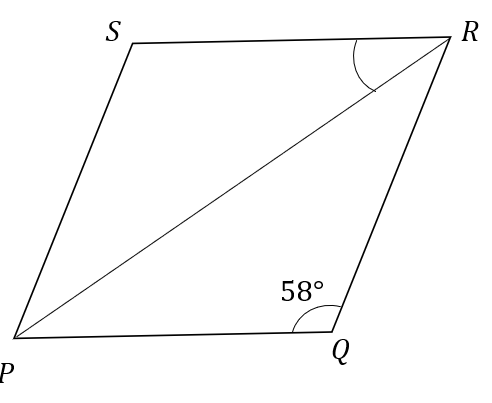
PQRS is a rhombus with \[\angle PQR = 58^\circ \]. Determine \[\angle PRS \].
Answer
591k+ views
Hint: The quadrilateral having all sides of equal length is called rhombus. The adjacent sides of a rhombus are supplementary. The diagonal of a rhombus is angular bisector.
Complete step-by-step answer:
Consider a rhombus \[PQRS\] inside of a circle as shown below.

Since, the adjacent sides of a rhombus are supplementary, it can be written as follows:
\[
\angle QRS + \angle PQR = 180^\circ \\
\angle QRS = 180^\circ - \angle PQR \\
\angle QRS = 180^\circ - 58^\circ \\
\angle QRS = 122^\circ \\
\]
Since, the diagonal of a rhombus is angular bisector, so the \[\angle PRS \] is half of the\[\angle QRS\].
\[
\angle PRS = \dfrac{{\angle QRS}}{2} \\
\angle PRS = \dfrac{{122^\circ }}{2} \\
\angle PRS = 61^\circ \\
\]
Thus, the value of the \[\angle PRS \] is \[61^\circ \].
Note: The adjacent sides of a rhombus are supplementary and the diagonal of a rhombus is angular bisector. These two properties should be known to students to solve this problem.
Complete step-by-step answer:
Consider a rhombus \[PQRS\] inside of a circle as shown below.

Since, the adjacent sides of a rhombus are supplementary, it can be written as follows:
\[
\angle QRS + \angle PQR = 180^\circ \\
\angle QRS = 180^\circ - \angle PQR \\
\angle QRS = 180^\circ - 58^\circ \\
\angle QRS = 122^\circ \\
\]
Since, the diagonal of a rhombus is angular bisector, so the \[\angle PRS \] is half of the\[\angle QRS\].
\[
\angle PRS = \dfrac{{\angle QRS}}{2} \\
\angle PRS = \dfrac{{122^\circ }}{2} \\
\angle PRS = 61^\circ \\
\]
Thus, the value of the \[\angle PRS \] is \[61^\circ \].
Note: The adjacent sides of a rhombus are supplementary and the diagonal of a rhombus is angular bisector. These two properties should be known to students to solve this problem.
Recently Updated Pages
Master Class 12 Business Studies: Engaging Questions & Answers for Success

Master Class 12 Economics: Engaging Questions & Answers for Success

Master Class 12 English: Engaging Questions & Answers for Success

Master Class 12 Maths: Engaging Questions & Answers for Success

Master Class 12 Social Science: Engaging Questions & Answers for Success

Master Class 12 Chemistry: Engaging Questions & Answers for Success

Trending doubts
What is BLO What is the full form of BLO class 8 social science CBSE

Citizens of India can vote at the age of A 18 years class 8 social science CBSE

Name the states through which the Tropic of Cancer class 8 social science CBSE

Full form of STD, ISD and PCO

Right to vote is a AFundamental Right BFundamental class 8 social science CBSE

Summary of the poem Where the Mind is Without Fear class 8 english CBSE




